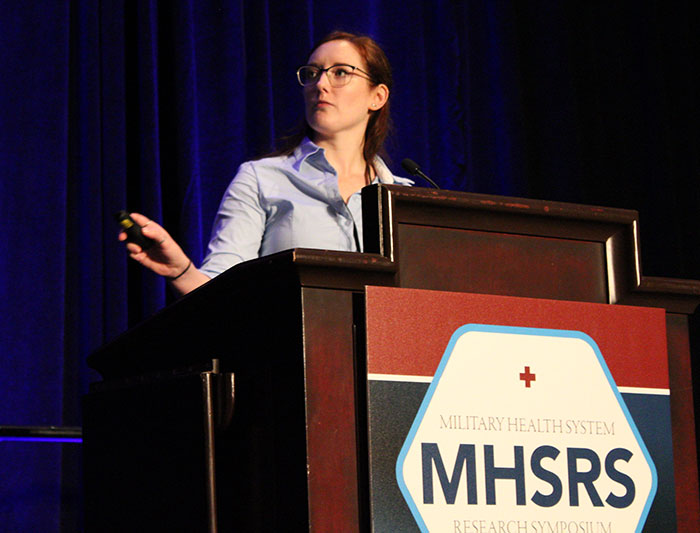At MHSRS, MRDC's Plan to Boost Solider Health, Resilience Unfolds

Lee Margolis opened his presentation on the second full day of the 2022 Military Health System Research Symposium in Kissimmee, Florida, with a sure-fire joke – one that he'd been waiting to use since 2020. After a pair of MHSRS events had previously been cancelled due to the COVID-19 pandemic, Margolis, a nutrition physiologist at USAMRDC's U.S. Army Research Institute of Environmental Medicine, was finally able to discuss two years' worth of research to an eager crowd of attendees.
"We've got a very diverse and unique set of data being presented today," said Margolis, the moderator for the "Advances in Warfighter Nutrition" session. "It's so good, in fact, that I've been waiting the past two years to talk about it."
That line – which did elicit laughs from the audience – in many ways underscored the importance of the information to follow. While the lengthy COVID-19 pandemic placed a spotlight on the overall health of the nation, scientists at USAMRDC also using that time period to study the health – or, in more specific terms, the overall physiology – of the nation's Service Members. The studies performed in the meantime have since borne fruit, allowing a closer look into how to make and mold a more resilient force.
"It's no secret that people in the military don't get enough sleep," said Emily Stekl, a clinical research coordinator at USAMRDC's Walter Reed Army Institute of Research, during her afternoon presentation on sleep-enhancement technology. "While a little over one-third of the civilian population gets less than the recommended seven-to-nine hours of sleep per night, that number spikes to more than 75 percent for members of the military."
While extenuating circumstances – especially when it comes to body rest – are expected byproducts of the military lifestyle, experts say sleep remains a key predictor of enduring mental and physical health. Stekl's presentation revealed, via a comprehensive review of smartphone-based sleep aid applications, that some such applications – most notably the popular Calm and Headspace apps – show at least partial evidence that support their claims of being functional sleep aids via their use of scientifically-supported techniques previously shown to reduce sleep latency. While evidence regarding the efficacy of said applications is lacking, according to Stekl's work, the information ultimately translates into immediate support for weary Soldiers.

During a presentation on the potential use of dietary supplements (i.e. ketone esters) as an alternative fuel source to carbohydrates during exercise, Emily Howard, also a nutrition physiologist at USARIEM, found that contrary to popular opinion, consuming carbohydrate-rich foods remains the key to unlocking top physical performance for certain military activities.
"Carbohydrate supplementation remains the superior fuel choice compared with ketone esters for enhancing and sustaining physical performance when consumed before and during aerobic exercise," said Howard, noting that, despite her findings, the ketone ester craze has only grown in recent years, a movement prodded along chiefly by top athletes, primarily by those in the field of endurance training.
A more comprehensive approach to Soldier fitness (and the accompanying benefits of readiness and resilience) may be found in the Army's Holistic Health and Fitness program, an effort launched in 2017 and designed to place certified trainers and health professionals within specific Army units (and now, after several years, across the Army at the brigade level as well). Given that 17 percent of Active Component Soldiers are obese – along with 25 percent of Reserve and National Guard Soldiers – and that more than half of AC Soldiers sustain a musculoskeletal injury each year, it only stands to reason that a more dynamic approach might help provide more dynamic results.
Following a lengthy 18-month investigation across two separate groups, Maj. Julianna Jayne, a member of the Military Nutrition Division at USARIEM, found that initial data shows a connection between embedded health professionals and an increase in Soldier and unit health and readiness.
"The data we've collected shows that investments like the Holistic Health and Fitness program may have the potential to provide a positive impact across all Service branches," said Jayne, further noting that her data processing efforts, all of which was derived from both in-person observation and a battery of standard Army questionnaires, were still in the early stages.
Just as the Army remains committed to improving Solider health and wellness as a means to further improve Force readiness and resilience, it also seeks to regularly assess efforts in these areas for the purpose of refinement and improvement.














